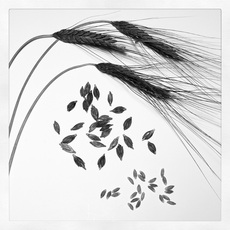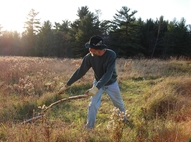 Black Winter Emmer Black Winter Emmer Ever wonder how to get the hulls off of your homegrown Einkorn and Emmer, so you can eat them? I have heard of this solution, but I haven't tried it yet. Here is a video on YouTube of a simple way to do it. At 1:00, notice that a thick, flat rubber ring has been mounted over the main steel plate of a Corona or Porkert grain mill. The other steel plate is left bare. The grain heads are cut off the stems, and then run through the grinder. The plates need to be adjusted for firm, but not crushing pressure. As you turn the crank, the metal teeth of the steel plate, rubs the hulled grain against the rubber plate, and the friction rubs the hulls apart. Then the grain is separated from the chaff, by winnowing it in the wind. On an even smaller scale, you can use the ancient method of toasting the hulls in a frying pan until very dry, then crushing the hulls with a mortar and pestle, and then winnow in the wind to separate the grain from the chaff. - Botan Anderson
2 Comments
A History of Harvesting Grains, from the Scythe to Gigantic Modern CombinesWhile it's amazing what a $500,000 combine can do, how does a small acreage farmer homesteader grow and harvest their own grain? Even small walk-behind combines cost a fortune. From 4:40 to 14:14, the above documentary shows how grains used to be harvested by hand, with a scythe and a flail. There is some good historical footage in this video. While the modern reenactment was done when the grain was at peak ripeness, the narrator explains at 6:55 that grains were traditionally harvested with a scythe before peak ripeness, so fewer grains would get knocked loose while harvesting. Then the grain was tied into sheaves and stacked in the field, in shocks, to finish ripening. Modern combines harvest wheat at complete ripeness.
|
Botan AndersonArchives
March 2023
Categories
All
|

 RSS Feed
RSS Feed